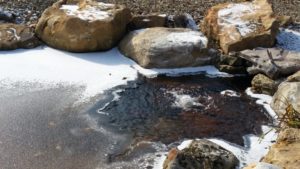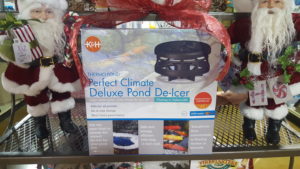
Its always a sad time when you have to winterize your sprinklers, swimming pools and ponds but shutting down your pond for the winter doesnt need to be a difficult task. Follow these steps and your life can be much easier!
Removal of excess organic matter and trimming
Putting a pond net over your water feature before leaves start falling from trees is the easiest way to contain and manage leaf control. Once all the leaves have fallen, simply roll up the net, discard the leaves, and put the net away until the next time it’s needed. If you leave your net on for the winter and even spring tighten up the net and remove any wet foliage and use your leaf blower to gently blow leaves off the top and rake up.
![]() .
.
If you didn’t install netting, you’ll probably have a build up of leaves and debris that need to be removed. A long-handled pond net makes an easy job of scooping the debris from the bottom of the pond. You can also use a Pond Vac to remove leaves and debris. If you leave the debris on the bottom of the pond, you’ll be creating a bigger mess to face in the spring.
Trimming dead foliage helps remove excessive organic debris that would otherwise decompose in the water. Cut back hardy waterlilies just above the base of the plant and cut back marginal plants that could droop over into the water.
Add cold water bacteria
Add cold water bacteria, such as Microbelift Autumn/Winter Prep Or Alpha Biosystems Aquaone, to help keep pond water clean and clear. Cold water bacterial products contain concentrated strains of beneficial bacteria designed to work in temperatures lower than 50 degrees. Regular use of cold water bacteria will help maintain water quality and clarity, as well as dramatically reduce spring maintenance by digesting debris that may accumulate over the winter months.

If you leave your pond running
Operating your pond and waterfalls during the winter will provide beautiful ice formations for you to enjoy throughout the frosty season. Keep in mind, there will be a bit of maintenance required this time of year, such as topping off the pond due to evaporation. Also, you’ll need to make sure ice formations don’t create dams that can cause unnecessary water loss over the edge of the stream.
If you shut down the pond
Many homeowners in northern climes choose to shut down the pond for the winter months. If you choose this option, remember to:
- Remove the submersible pump from your pond and store it in a warm place like the garage or the basement. Protection from the cold lengthens the life of your pump. If you have an external pump before to remove the drain plugs and disconnect all plumbing.
- Drain the water out of the plumbing. This prevents standing water from freezing and expanding, potentially cracking the pipes that connect your filtration system.
- Remove and clean the filter media and spray them thoroughly with a garden hose. Store them in the filter box or in an outdoor storage container. We don’t recommend storing the stinky media in the garage or basement.
- Oxygenate the water by placing a small recirculating pump, such as an OASE Aquarius Pump on the top shelf of your pond. Oxygenating the water is not only for the sake of your fish, but it also helps keep a hole open in the ice when the surface of your pond starts freezing. This hole allows harmful gasses to escape, and oxygen to get in. You can also use a pond aerator such as AirMax Koi Air Mini, 1, or 2.
- If it gets really cold where you live, you may consider adding the K&H Floating Pond DeIcer. At extremely low temperatures, the oxygenation of the water may not be sufficient to keep a hole open in the ice. This is where a deicer really benefits the pond. It compliments the bubbler and, together, they’ll keep most any pond open.
The Dont’s
- DO NOT use a hammer, a rubber mallet, an ax, a shovel, or any other household weapon to break the ice.
- Using anything other than a pond heater or bucket of hot water can cause your fish to go into shock, not to mention that you may accidentally injure a fish using another method.
- You can also damage the liner in your pond; This can be a major, and expensive, problem come spring.
Ensure healthy fish before winter
A well-balanced diet creates healthy, happy fish. You want to make sure your fish are in good condition before they go into hibernation. When the water temperature falls below 50 degrees, the metabolism and digestion of your fish begins to slow down. Microbelift Cold Weather Fish Food is scientifically formulated to properly nourish your fish during these lower temperatures. Be sure to stop feeding your fish when the average water temperature falls below 40 degrees.
Taking a little time and effort to prepare your pond for winter not only helps your fish survive their winter slumber, but makes your spring maintenance much easier. Be sure to follow these winter guidelines so you can experience the greatest joy from your pond when spring rolls around once again.
